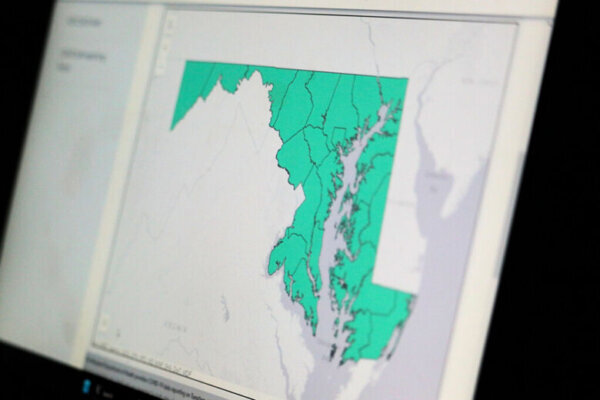This article was republished with permission from WTOP’s news partners at Maryland Matters. Sign up for Maryland Matters’ free email subscription today.
This content was republished with permission from WTOP’s news partners at Maryland Matters. Sign up for Maryland Matters’ free email subscription today.
The Maryland Department of Health has reduced the frequency that the agency will publish statewide COVID data to its public dashboard just once a week, after about three years of reporting COVID-related hospitalizations, deaths, and case rates on a daily basis. Now, the COVID dashboard for the state of Maryland will update on Tuesdays at 10 a.m.
The weekly COVID reports are part of the Department’s new COVID-19 web pages for information on vaccines, treatments and testing, among other resources.
Maryland’s state reporting changes reflect “the new phase of COVID-19 that we are in today,” according to Health Secretary Laura Herrera Scott in written statement last week.
But since the start of the COVID pandemic in 2020, the disease has gone through waves of low cases that then surge, so how did state health officials determine now is the time to reduce the frequency that data is published to the public?
According to Maryland’s health community and state officials, there are a variety of factors at play — currently low community risk, new antiviral therapies, and the presence of at-home COVID testing — that justify weekly reports of statewide COVID data.
Meghan McClelland, chief operating officer for the Maryland Hospital Association, said the changes in statewide COVID-19 data reporting should not be of concern.
“Hospitals track their COVID-19 patients, and patients overall, on a daily basis. They are currently seeing the lowest number of inpatients since the start of the pandemic in early 2020,” McClelland said in a written statement to Maryland Matters.
That said, in January, the association reported that hospitals were almost at capacity due to “another steep uptick in Marylanders needing hospitalization for COVID,” Maryland Matters reported at the time.

The New York Times recently reported that while COVID cases and deaths have plummeted compared to recent years, “it’s always possible for a new variant to emerge and start another wave.”
Sen. Clarence Lam (D-Anne Arundel and Howard), a public health physician, warned that the reduced reporting may lead to people relaxing COVID precautions.
“The biggest concern may be the potential that this could signal that it is time to stop taking any precautions related to COVID,” Lam said in an email. “Earlier in the pandemic, there was daily news reporting on our state’s COVID numbers, and it was a good reminder to the public of the need to take precautions. It is important that, as we move away from daily reporting, we remember that COVID is not ‘gone’ and that it continues to be important to take reasonable risk reduction steps.”
But he also says the move to weekly reporting “seems reasonable” at this time.
“Our current COVID numbers are reflective of what researchers have been predicting for a while: that COVID-19 is with us to stay and will become endemic like the flu, and we will likely seasonal rises in cases,” Lam added. “However, it is important to recognize that, even though COVID is now a permanent part of our lives, it does not mean that everything is back to a pre-pandemic ‘normal.’”
Dr. Amesh A. Adalja, a senior scholar at Johns Hopkins Center for Health Security and an adjunct assistant professor at the Johns Hopkins Bloomberg School of Public Health, said that at this point of the COVID pandemic, daily reports “do not have much value.”
That’s because the widespread use of at-home tests and the number of people who do not get tested for COVID means that daily case totals are “not reflective of the true burden of infection,” he said in an email.
“Because of the widespread immunity in the population from vaccines and prior infection, coupled to availability of antiviral therapy, Covid has become greatly more manageable than what it once was,” he added.
“Covid is becoming more like other respiratory viruses because of the tools medicine and science have … provided,” Adalja explained. “Weekly tracking is reasonable at this stage of the pandemic when there is no longer concern about the healthcare system’s capacity.”
Del. Joseline Peña-Melnyk (D-Anne Arundel and Prince George’s) believes Maryland health officials will respond appropriately if the COVID pandemic were to worsen.
“I trust that if the situation were to change, the administration and leadership at the Department of Health will respond in the best way to help all residents of our state,” she said in an email.
What’s in the new data?
As of Tuesday, the Department of Health reports that all of Maryland’s 23 counties and the city of Baltimore have a “low” COVID community risk. The COVID case rate for Maryland was 2.96 per 100,000 people as of Monday data.
There are 96 people currently hospitalized for COVID-19, with three pediatric cases. A dozen Maryland residents died from COVID-19 since last Tuesday, April 25.
It appears that information the state’s COVID vaccination rates will not be a part of the new weekly updates.
Previously, the Department of Health reported the percentage of Marylanders who had at least one COVID vaccine as well as the percentage of those who received two vaccines.
Federal health officials have adjusted COVID vaccination recommendations over the past several years. The CDC now recommends the initial vaccination regimen, two-doses for Pfizer and Moderna and one-dose for Johnson & Johnson, as well as an updated booster to better combat new variations of COVID-19, according to the CDC website.
Maryland Matters will continue publishing our COVID-19 data page, as the underlying information is available.







